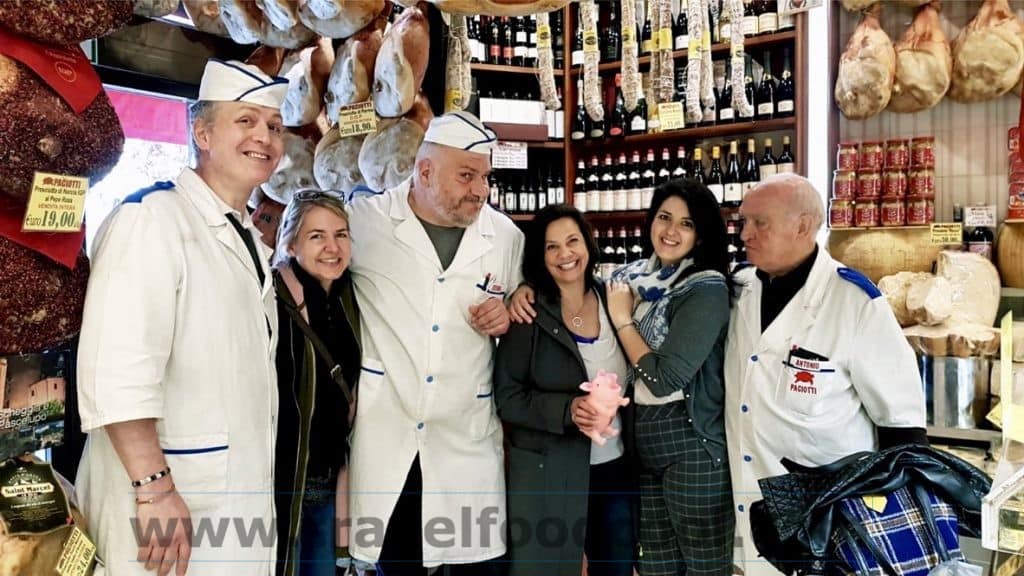
In the shadow of the Vatican and a few blocks away from Vatican square, lies the Prati neighbourhood. This area is off the sightseeing grid and, on the whole, tourist-free. This is a working Roman neighbourhood and there is not a tourist sign to be seen. On a slightly overcast spring day, I set off with my friend and TravelFoodCool reader (thank you!), Tracy, to explore the foods of Italy on a Rome Food Tour!
We take the Rome Metro one stop past the Vatican station to the “Cipro” stop where we immediately realize how lucky we are upon meeting our energetic guide, Luisa.
Do NOT eat breakfast. I’m not kidding – you may also want to pass on dinner the night before you do this tour. There are so many things to try. You definitely do not walk away hungry. Please note that the tours are tailored to accommodate dietary issues.
First stop: Sicily!
La Siciliana – the Sicilian ladies
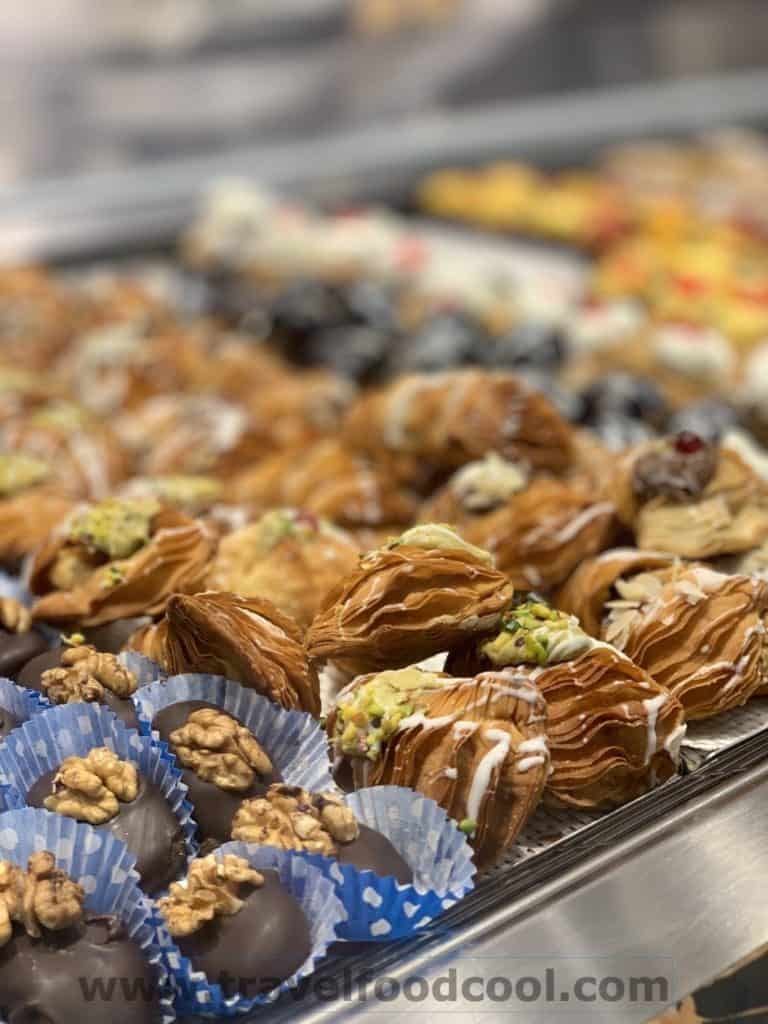
We come for a coffee and a cannoli that is freshly stuffed before our eyes with sheep’s milk ricotta and sugar.
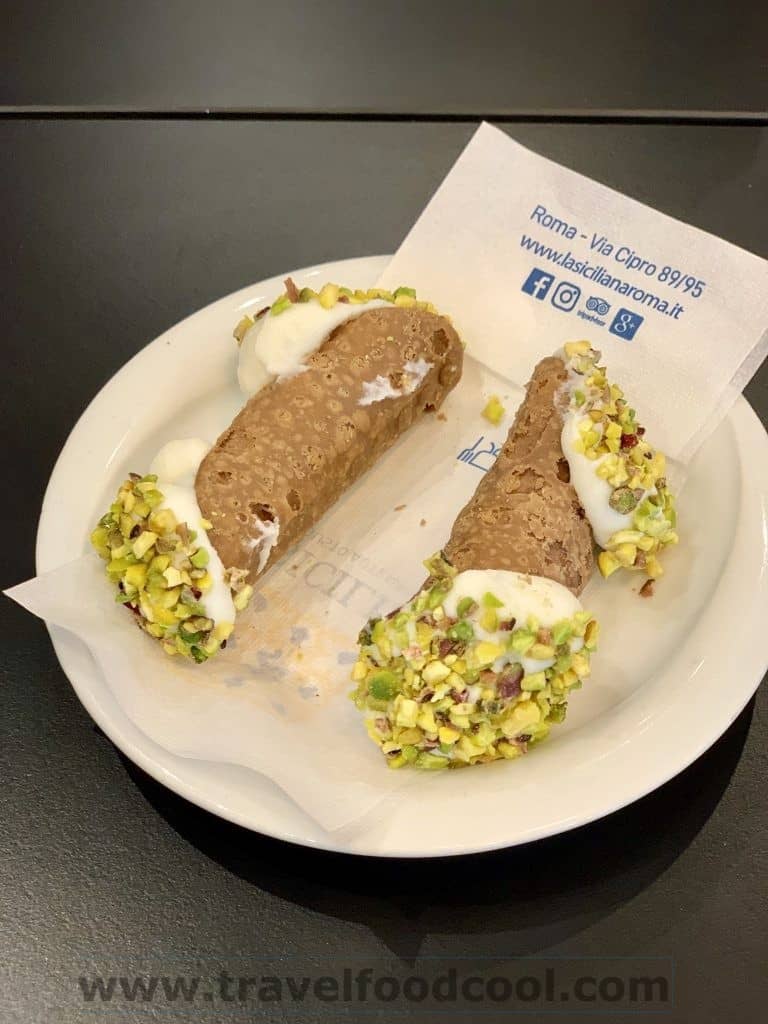
We then have a choice of items in which the the ends of our cannoli will be dipped. Pistachio, chocolate chips, almonds, candied orange peel or cherries. How can I resist those pistachios?
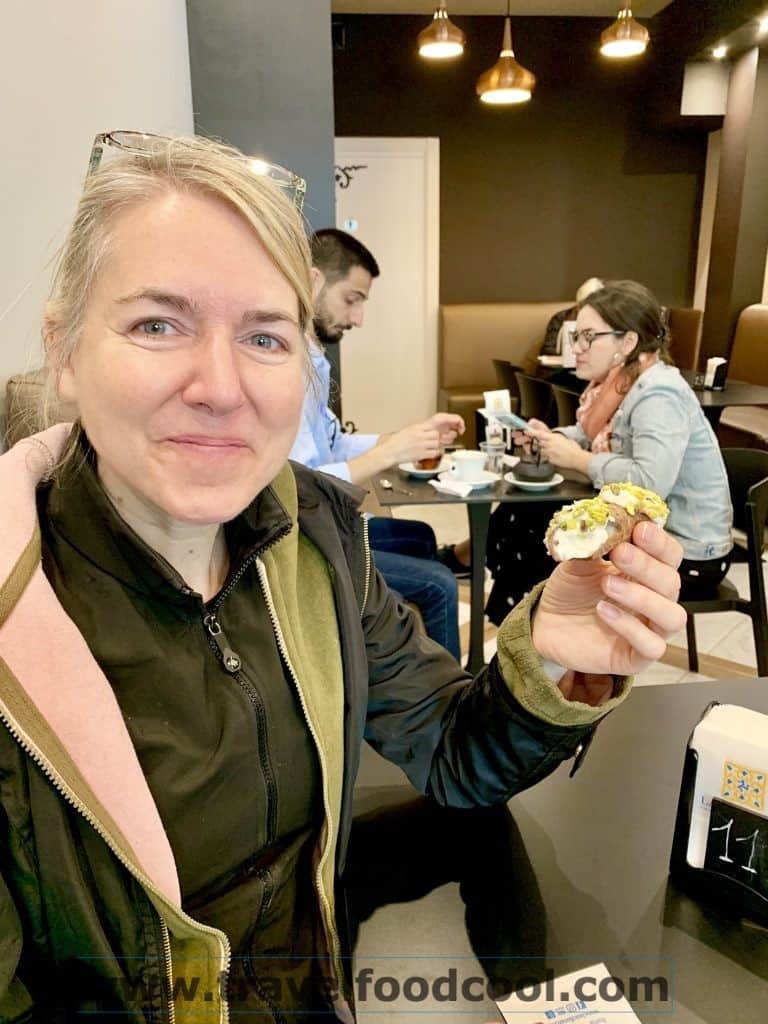
As we sip and munch what Tracy calls “the best cannoli she has ever had”, Luisa fills us in on some information. For instance, when you walk into a bar, if you stand up, the espresso is usually not more than €1.20 and cappuccino is €2.00.
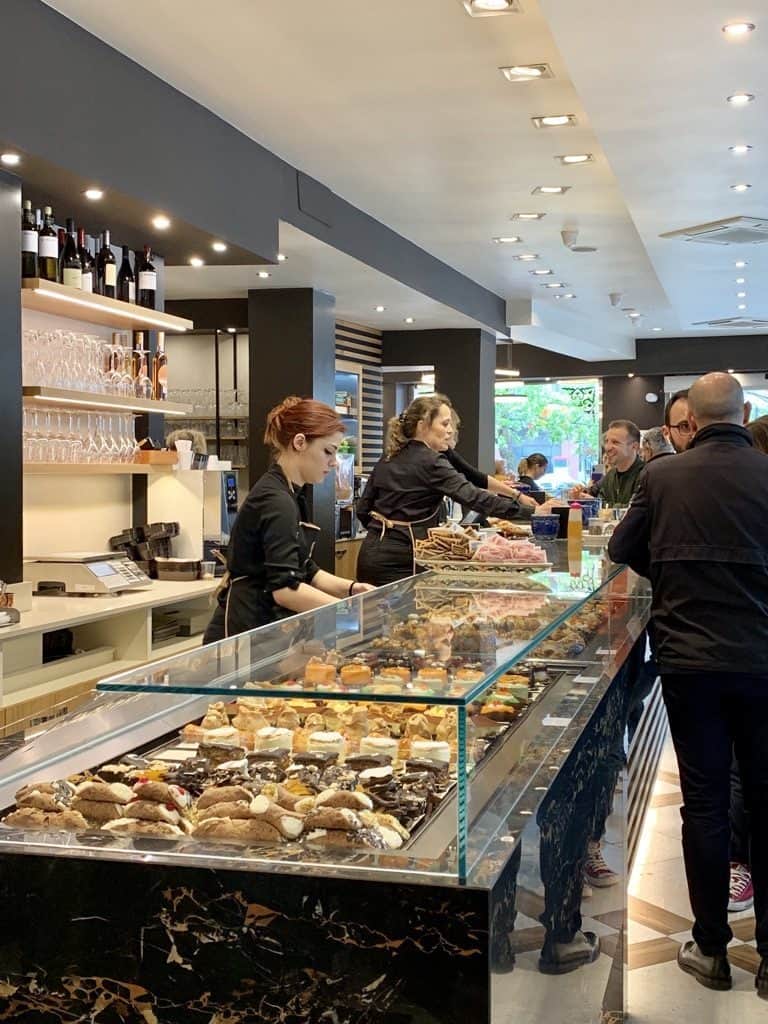
However, if you sit down, they can charge more – a lot more. Please take note of this if you are sitting for a coffee in the Piazza Navona, Piazza della Rotunda, Piazza del Popolo or Piazza San Marco (Venice) – and do not be surprised if your “caffe normale” costs a LOT more than normale!
Some fun coffees your can order?
- Caffe corretto – I love this, as the name suggests that the coffee needs to be corrected with the addition of alcohol – usually Anise or Grappa!
- Caffe macchiato – this is a coffee with a slight “stain” of milk.
- Latte macchiato – this is hot milk with a slight “stain” of coffee
- Cappuccino – a big frothy milk-based coffee
- Espresso – or “caffe normale” – if you order coffee in Italy, this is what you will get – if you want it like a drip coffee at home, you can ask for an “Americano”.
- NOTE: do not order a “latte” – in Italian “latte” means milk. So instead of the expected coffee and steamed milk creation, you will get a glass of steamed milk! For a typical North American latte, you should order a “caffe latte”.
Naples is considered the city of coffee. So important was coffee that, to help those less fortunate, a system developed in which a patron could order and pay for two coffees: their own coffee and a “caffe sospesso” or “pending coffee”. A less fortunate patron could then walk into the bar and ask if there was a “caffe sospesso”. If yes, they would be given the coffee paid for by the first patron.
Speaking of southern Italy, Sicilian desserts are originally from Saracens who lived in the southern parts of Italy. Luisa commented that the further south you go, the better is the pastry! So pastry lovers, don’t forget to head south!
Bonci pizza is our next stop. Why is there such a big lineup so early for takeaway pizza? This, after all, is a place that sells pizza by the slice. Gabriele Bonci is a famous chef and has a tv show called “Pizza Heroes”. The reason everyone is going crazy? He has been called the Michelangelo of pizza (by the New York Times, no less) and has also been given rave reviews by CNN. Is there a better endorsement than what Anthony Bourdain said about him? “It’s amazing … you want it. You want it bad. Your life would be so much better if you have this right now. Leave your family. Abandon your children. You know you want it.”
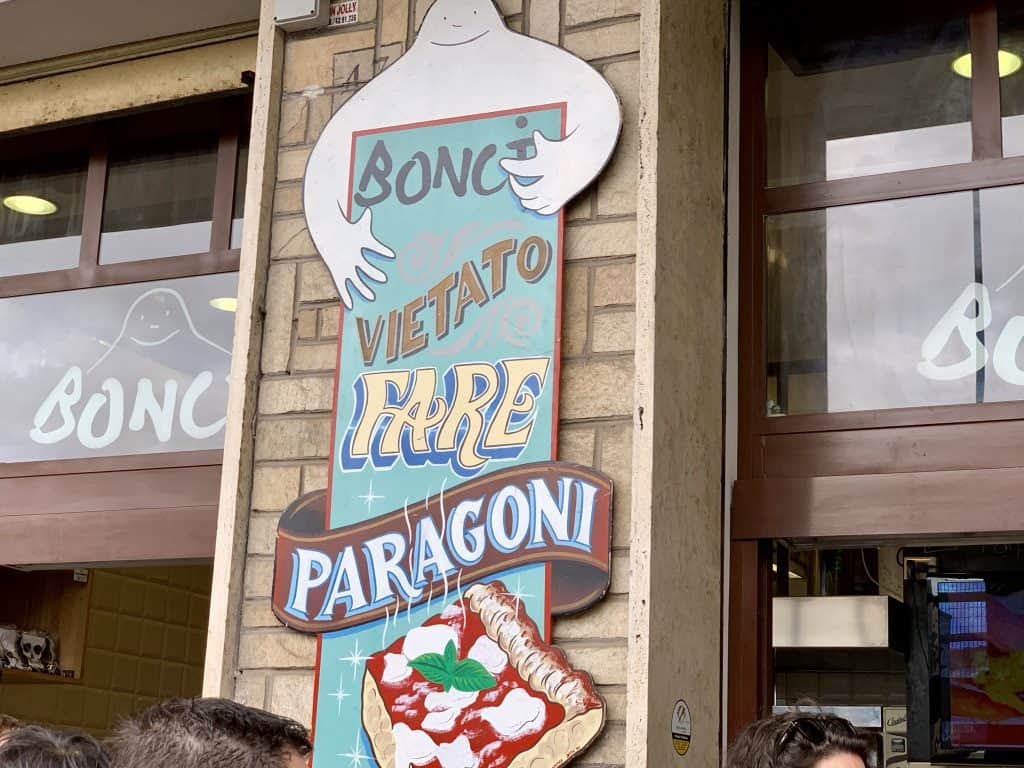
His secrets?
- The dough rests for 72 hours (vs the traditional 24 hours) allowing the gluten to break down as it rests.
- Great toppings.
- Three is considered the perfect number for toppings.
- The pizzas are different all the time. They are constantly changing. If you see one you like while you are waiting for your number to be called, it may be gone by the time it’s your turn!
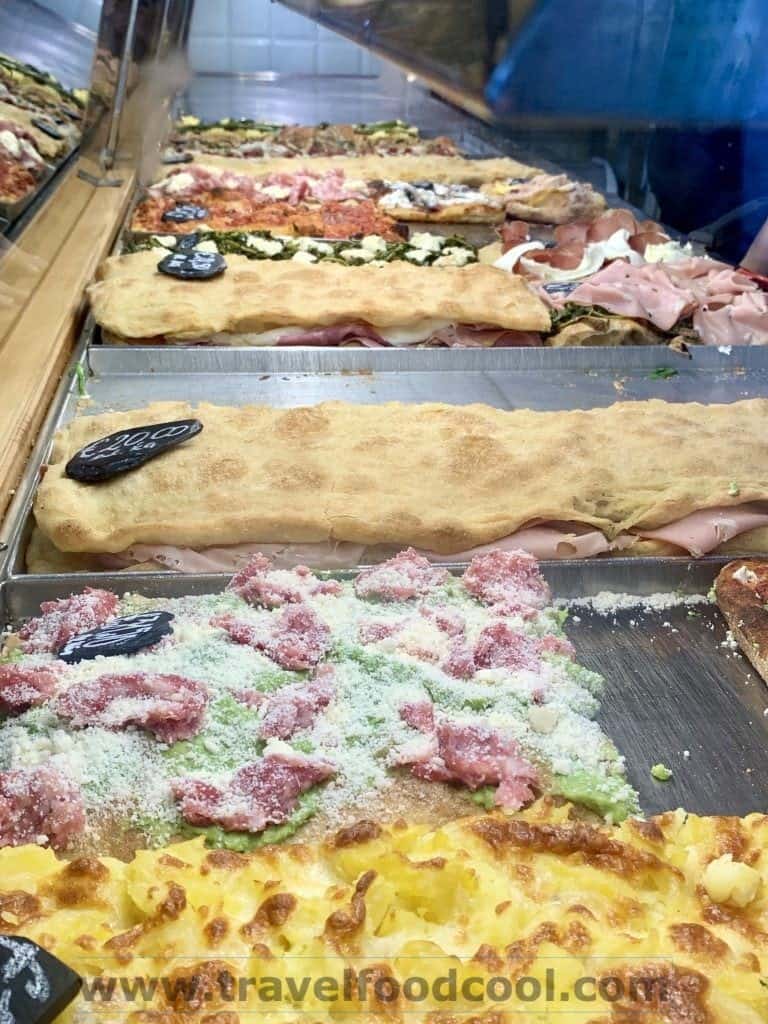
Luisa gives us a rundown on the history of pizza. Originally, pizza was thought of as food for poor people. Pizzeria Brandi (which still operates in the centre of Naples) opened in 1780, but in 1889, received a summons to make pizza for Queen Margherita (wife of Italy’s King Umberto I of the house of Savoy). In her honour, they created a tricolori pizza (which happened to also be the colours of the Savoy flag) and named the now-famous pizza with tomato sauce, buffalo mozzarella and basil, after her. To this day when you order a “Pizza Margherita”, you are giving a shout out to the former Queen of Italy!
Legend has it that they still have the letter to Raphael Esposito from the Queen, although theories abound that the letter is really (shhh!) a FAKE. (Interesting side note, the name Esposito is quite common. It means “exposed” and it was given to people children/orphans left in front of monastery or convent.)
But I digress! Luisa comes out with pizza for us! She has decided that we need to try a few (7!) different kinds!
Pizza:
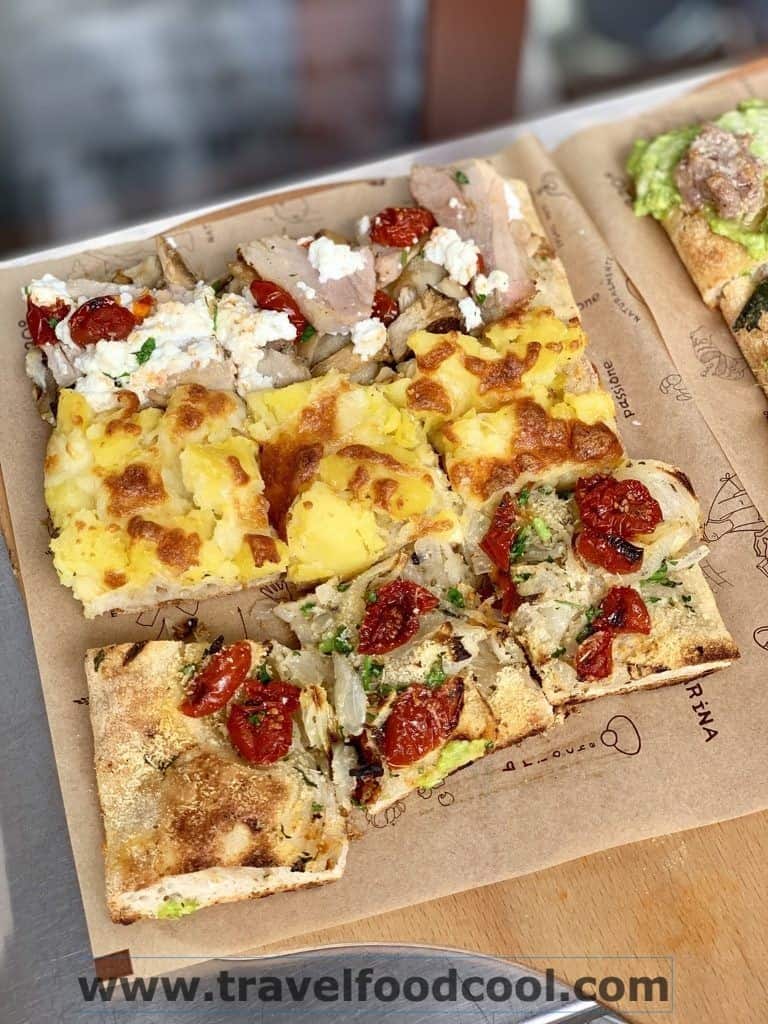
- Onion, sun-dried tomato, pecorino (bottom)
- Potato, mozzarella (middle)
- Porchetta, cow milk ricotta, mushrooms and sun-dried tomato (top)
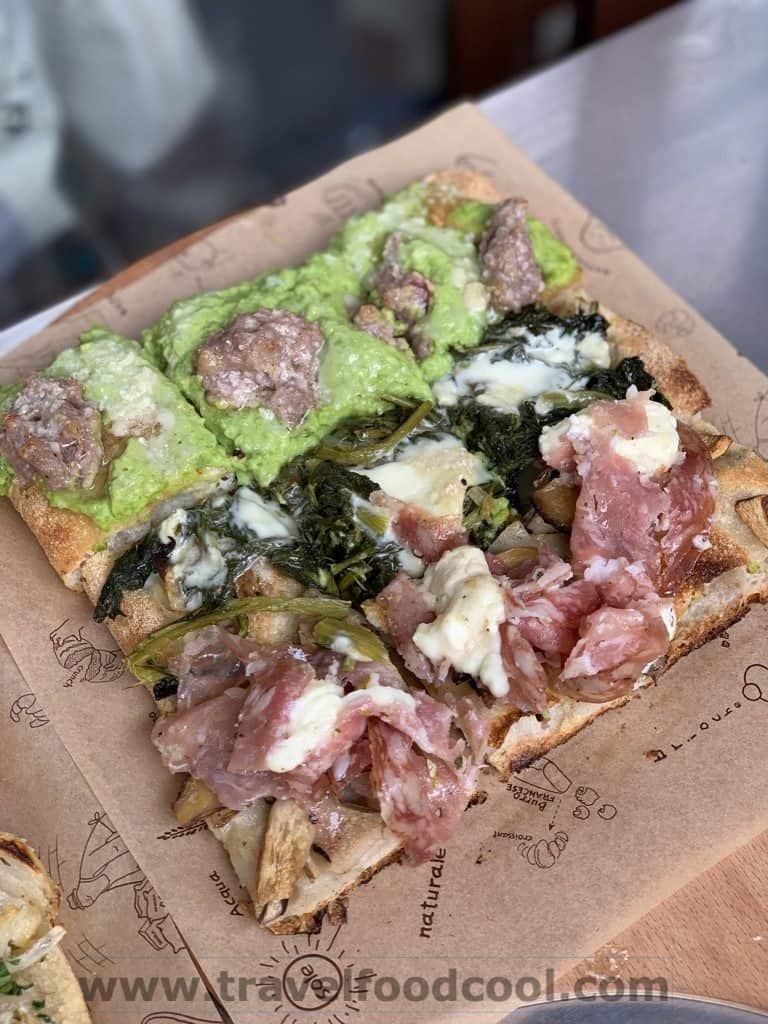
- Gorgonzola, salami, mushrooms (bottom)
- Sicilian broccoli with robiola (middle)
- Green pea cream and sausage parmigiano-reggiano (top)
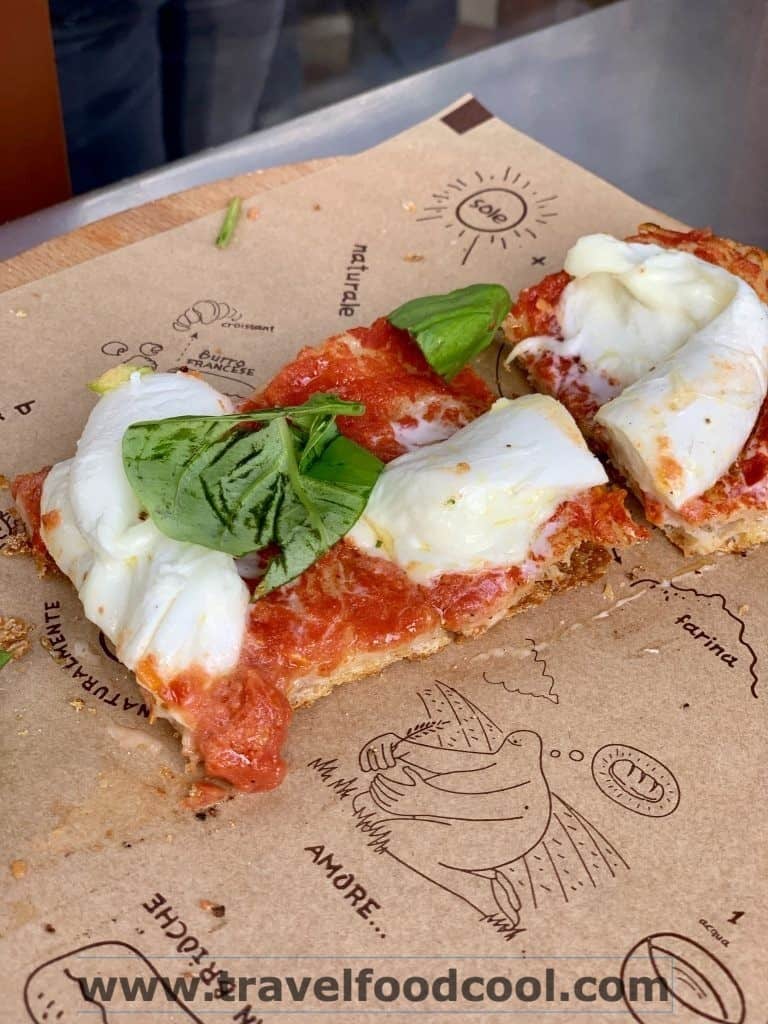
- Margarita with water buffalo mozzarella (above)
This place is so busy – it’s worth the price of the tour just so you don’t have to try to navigate this crowd!
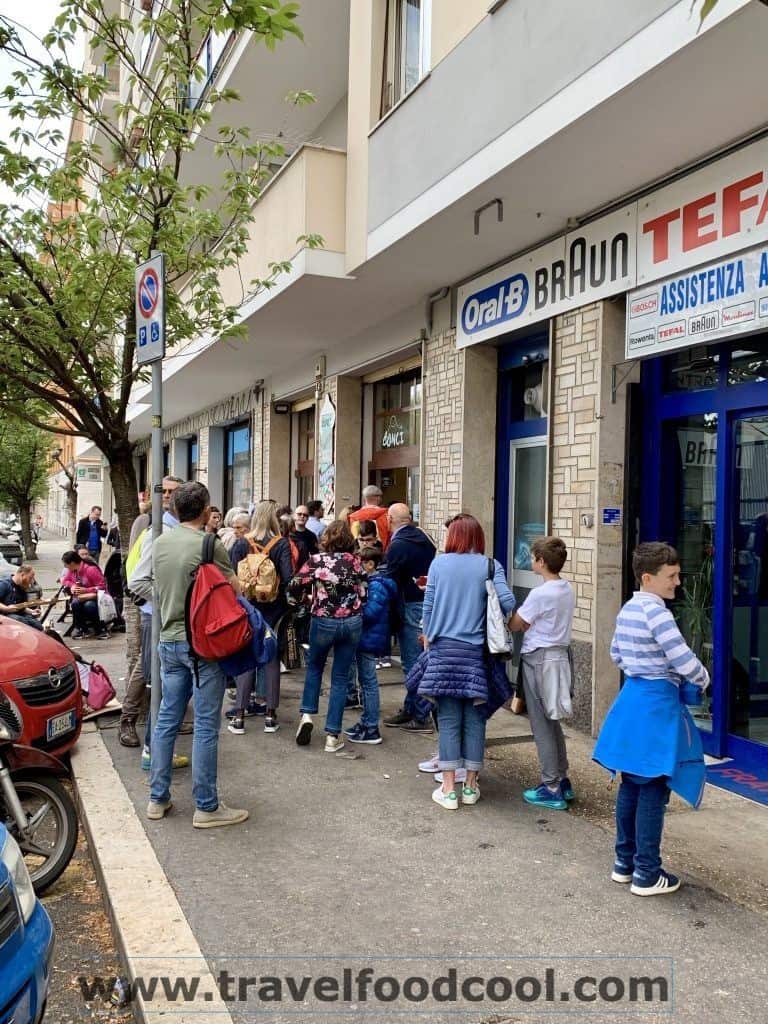
Paciotti – Prosciutto
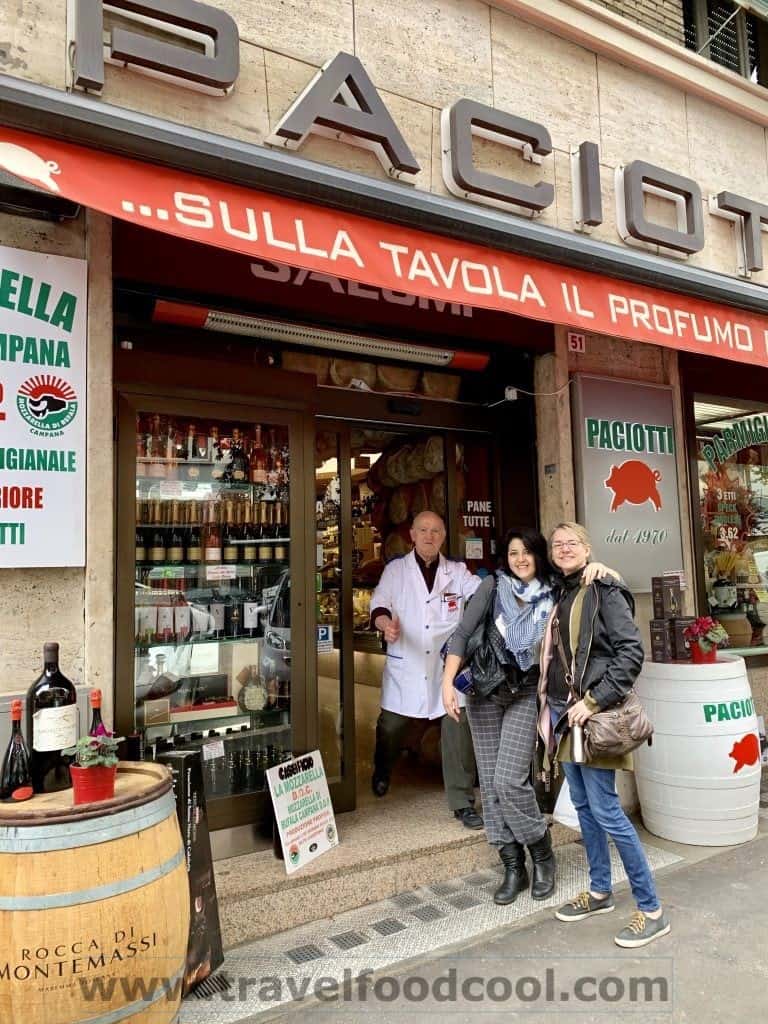
Antonio, the owner and father, greets us at the door.
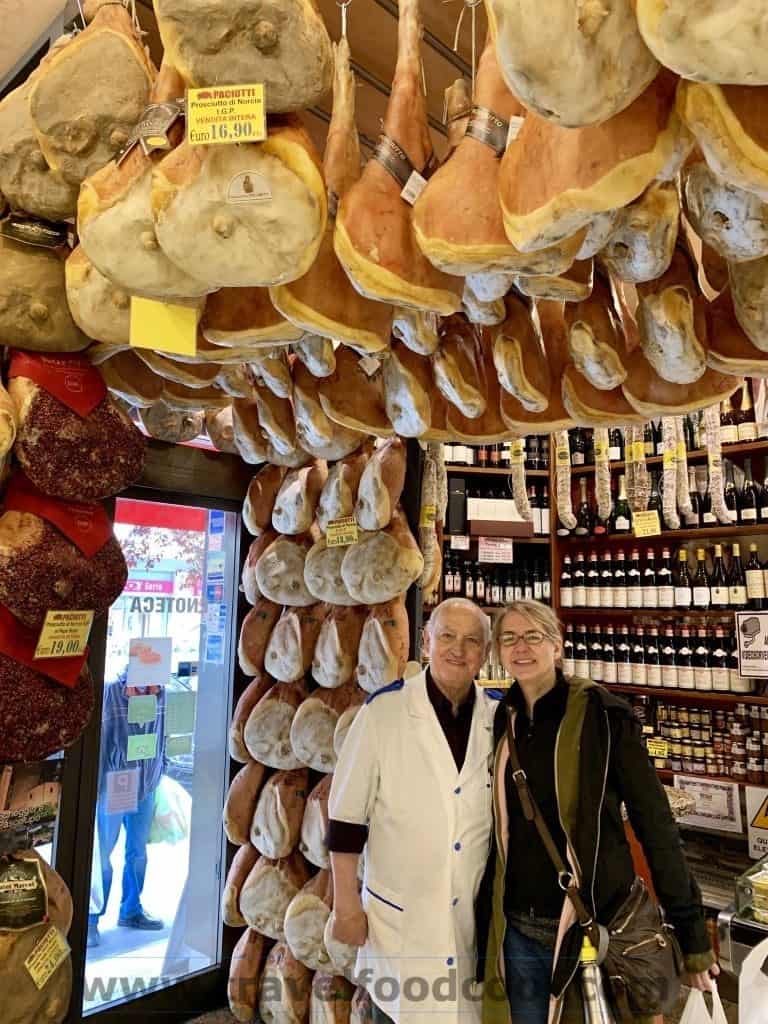
He still runs the business with his two children, Roberto and Stefano. Ladies, look out! Stefano is a charmer who has been married 4 times (you have been warned)! He endears himself to us as he opens up prosecco! Now the party can start!
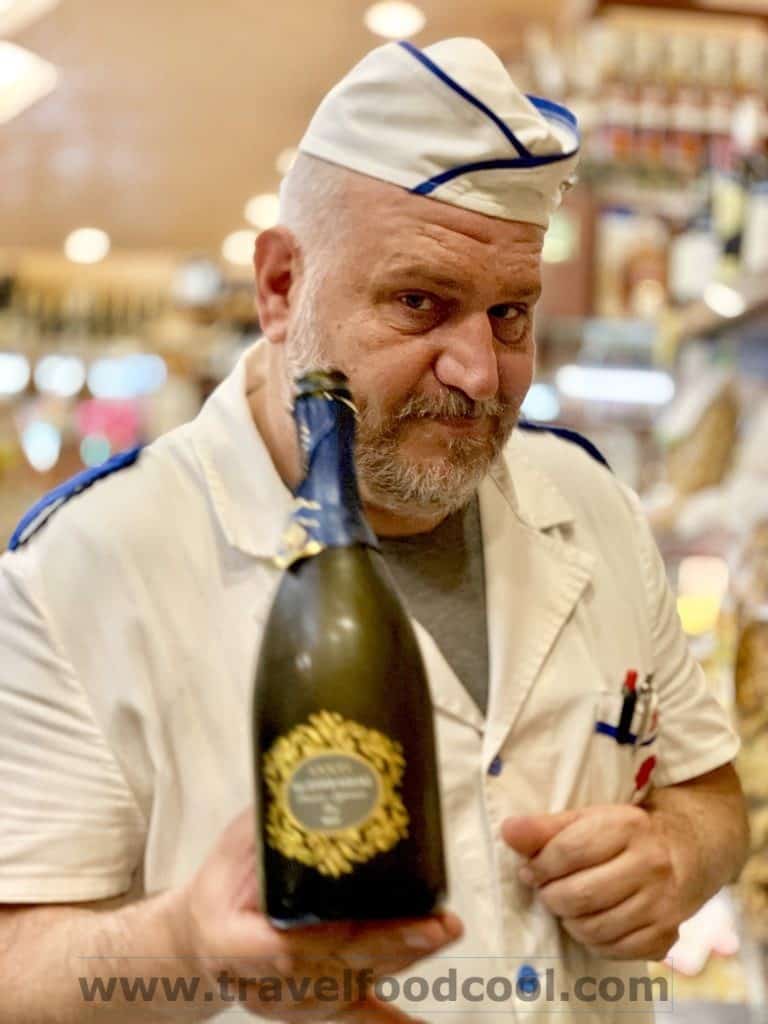
Prosciutto di Parma is a regional item. This means that the only area that can claim this product is Parma. Celiacs and those following gluten-reduced diets, take note, Proscuitto is gluten-free as it is simply rice flour, salt and fat used to cure the meats.
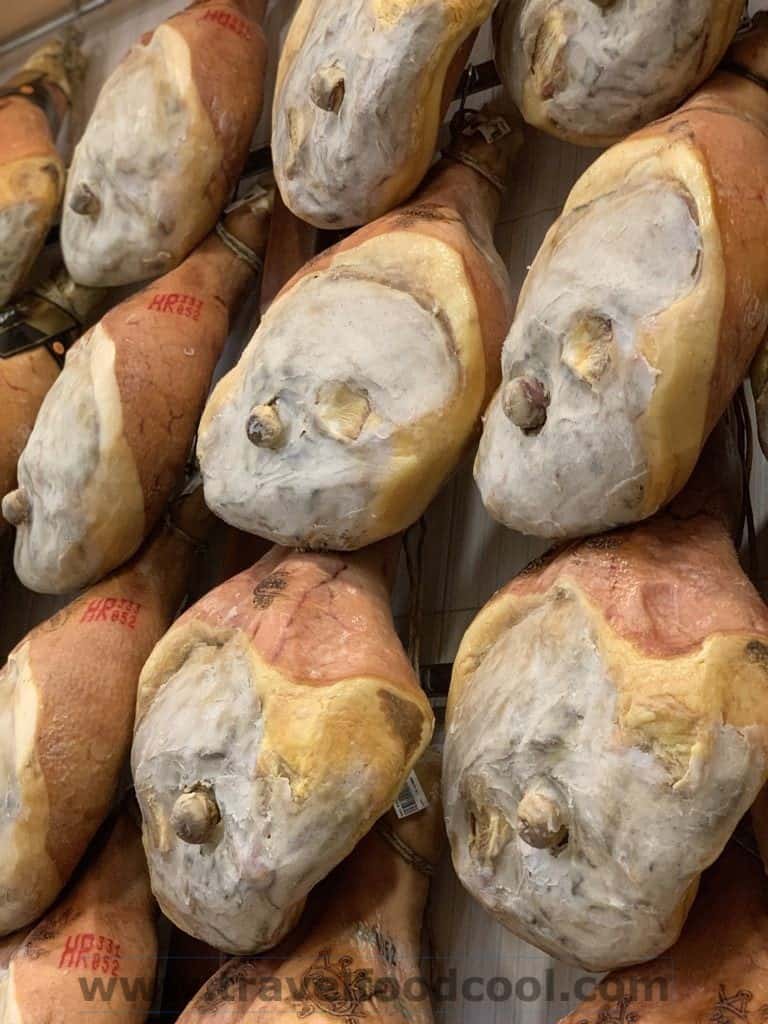
If you are looking at a leg of prosciutto, there will be one or two crowns on the leg. One crown means that the pig was born in Parma, if there is a second crown, it means that the pig was also killed and cured in Parma.
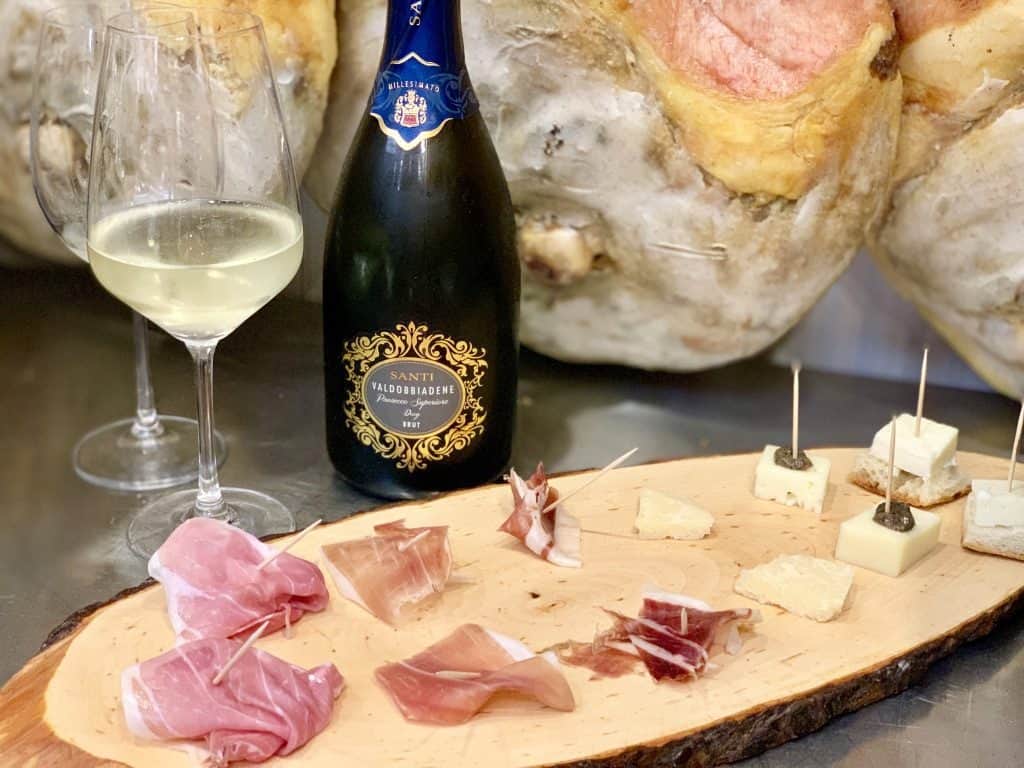
A quick rundown on your cured meats!
- Parma Prosciutto – a shorter leg and the pigs don’t move a lot. There is no hoof. Cured 1-1/2 years (left)
- Cinta Sienese – free range from Siena – the fat melts in your mouth. Black and white pigs which are longer and slimmer than their eastern cousins. The hoof is on. It is cured a bit longer, 1-2 years (2nd from left)
- Patanegro – Spanish prosciutto. This is the most expensive in the world. This comes from an all-black pig that for 2 years eat acorns. It is cured 5 years by law (3rd from left)
And then the cheese!
- Robiola – this is a 3-milk cheese or a “tre latte”. It is made from a combination of cow, sheep and goat’s milk. The flavour changes due to the combination of milk. (right)
- DOP Asiago cheese (near Venetian) – this is cow’s milk cheese which is served with truffle pate made from pure black truffles (2nd from right)
- Parmigiano-Reggiano – another regional item, which can only come from the Parma area. How lucky are we? it is topped with 30-year-old balsamic vinegar, but more on this below. (3rd from right)
We learn how to check if the prosciutto is ready. A natural bone, from the tibia of a horse, is used. The bone is thick and it both absorbs flavour and releases flavour. You stick the tester near the prosciutto bone to smell if it is ready. The “expert nose” does it many times a day. They are able to tell if it’s salty or sweet. Once the bone has been stuck in the leg, the area immediately has to be covered up.
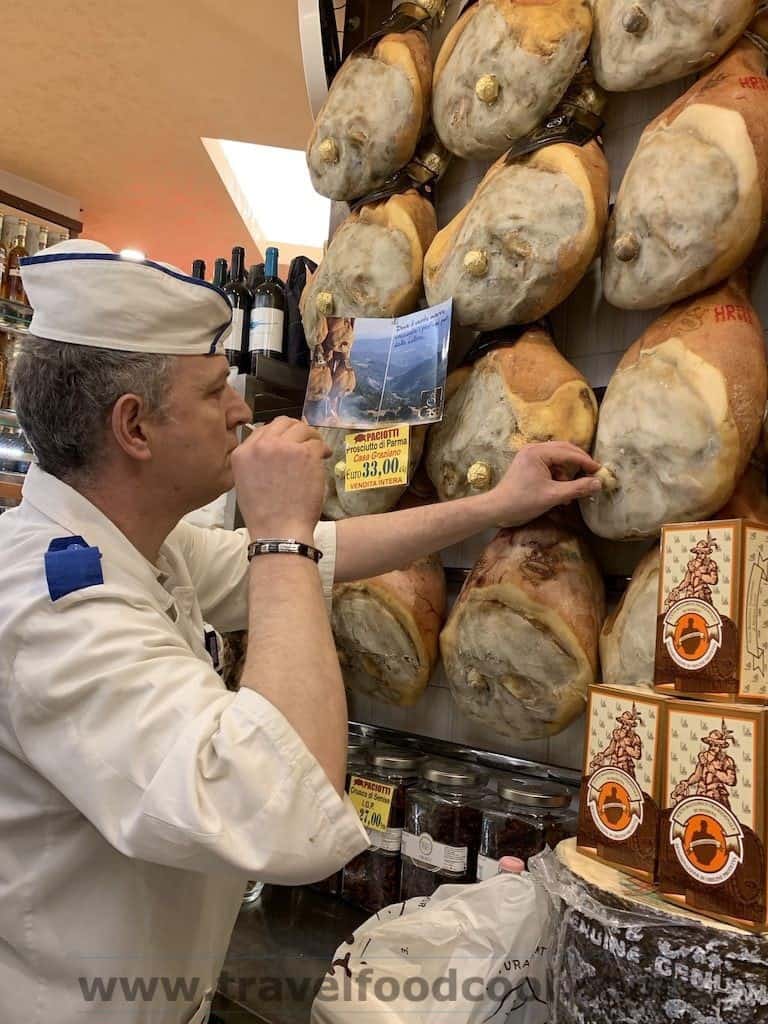
Balsamic vinegars are brought out, and not just any kinds of vinegar! A Bronze -12 year (€60); a Silver – 20 years (€120) and Gold – more than 20 years (€190).
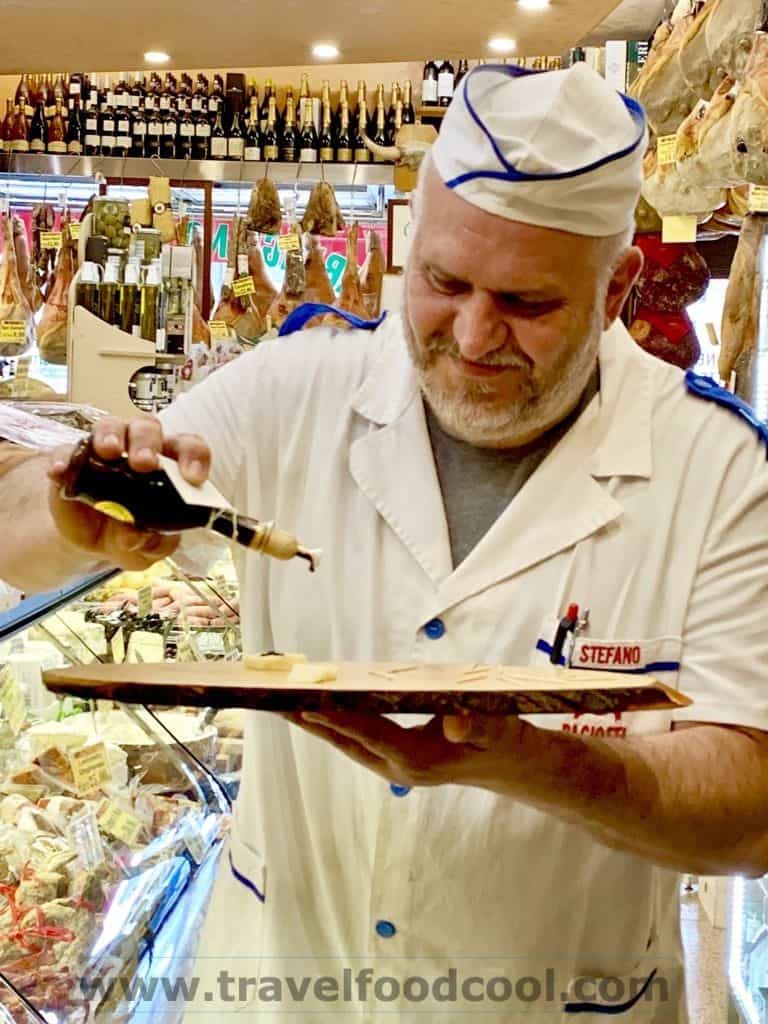
We get a dollop of the gold on the Parmigiano-Reggiano (and listen to Barry White, sorry Lionel Richie! – you will have to take the tour to get this joke).
We head next to Mercato Trifonale which is the largest indoor market in the area, and perhaps Rome. How big is it? There is a hair salon in the middle of the market!
The produce and products are all stunning! We visit a pasta store. These ladies make the most amazing pasta onsite!
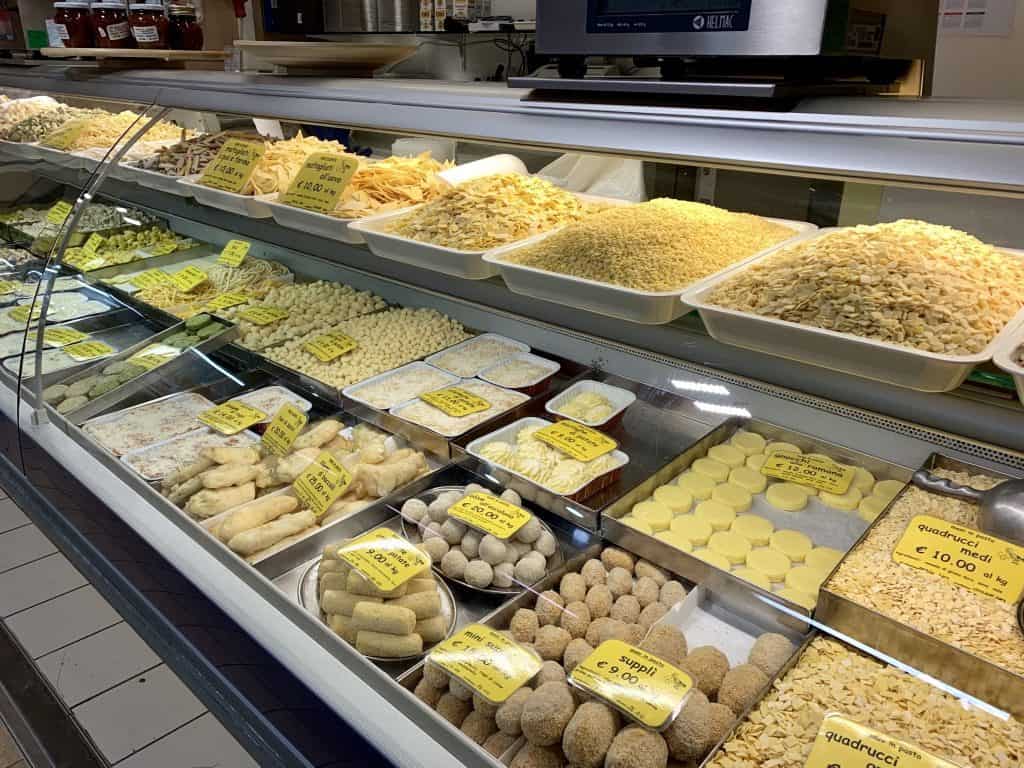
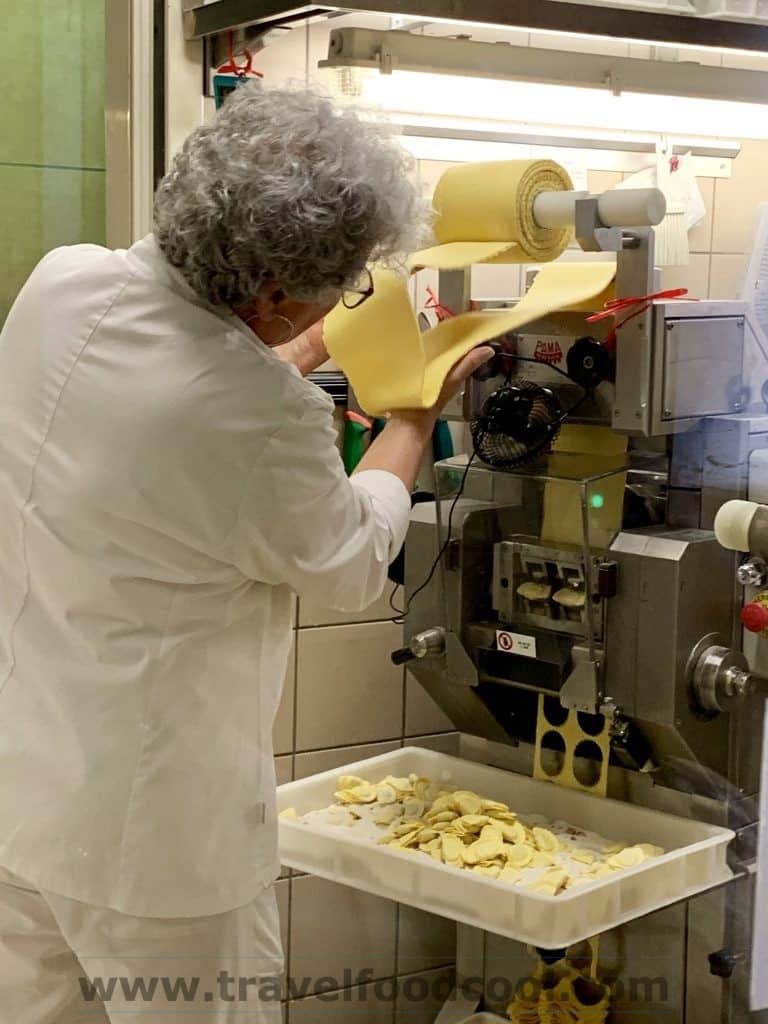
They also bring us eggplant Parmigiana!
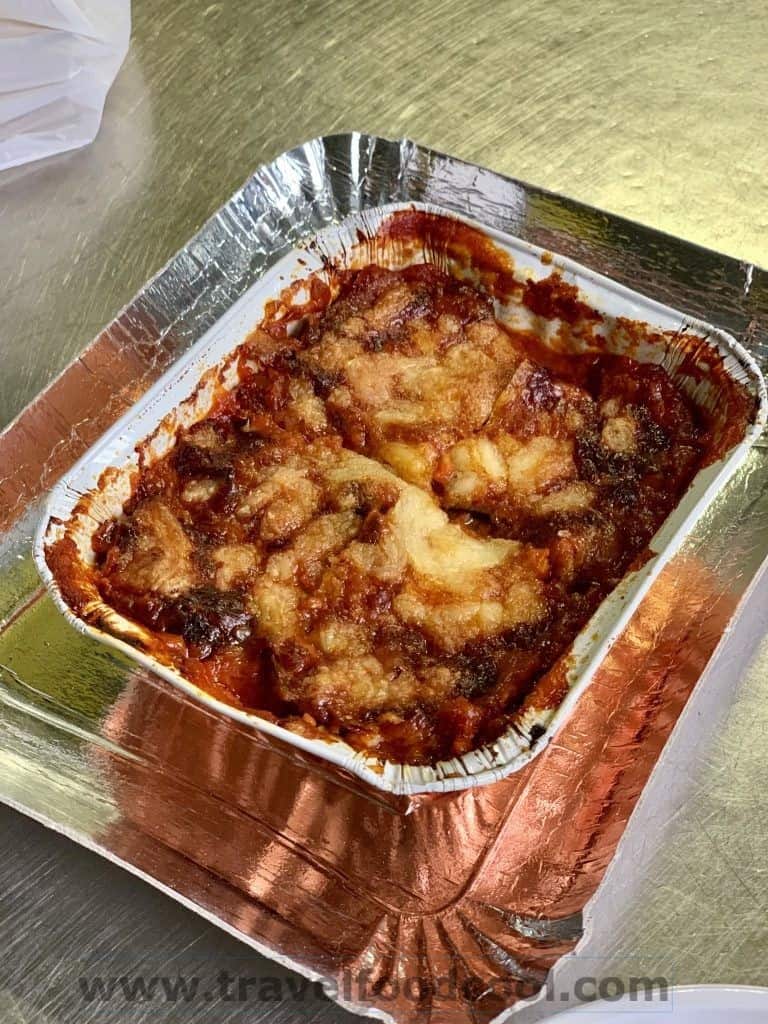
Eggplant parmigiana is served to us piping hot after being cooked in the oven. This incredible dish is basically just eggplants, tomatoes and cheese. You will not say “I don’t like eggplant” after trying this dish!
Now it is time for us to say “Cheese, please”!
Luisa makes two stops and picks up some plates for us to try.
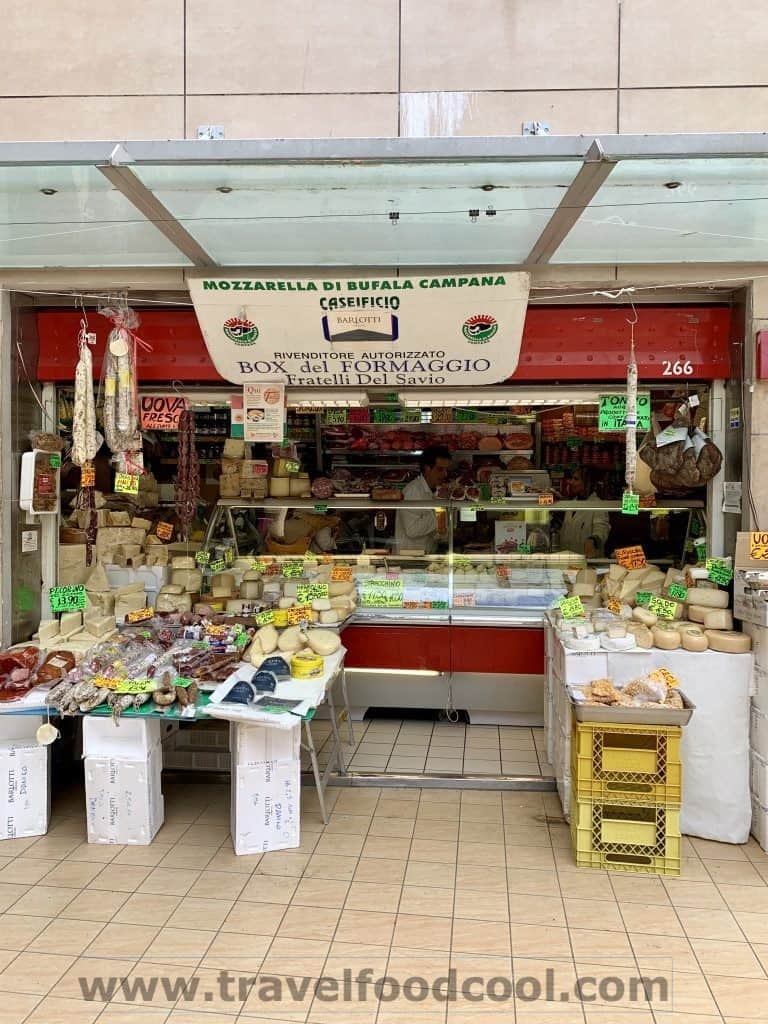
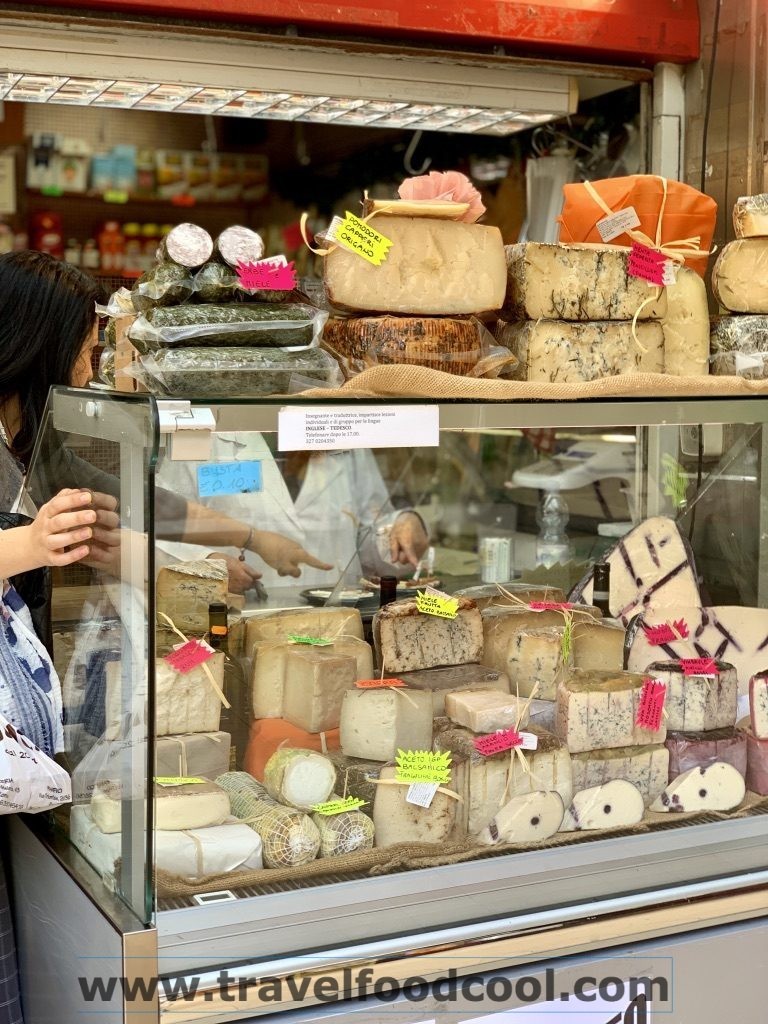
We have a classic Caprese made with water buffalo milk mozzarella. Water buffalo milk mozzarella must be fresh and must be eaten within 48 hours of being made as it is unpasteurized. This is also the reason that the water buffalos are cared for so well – there are no antibiotics for them if they are ill.
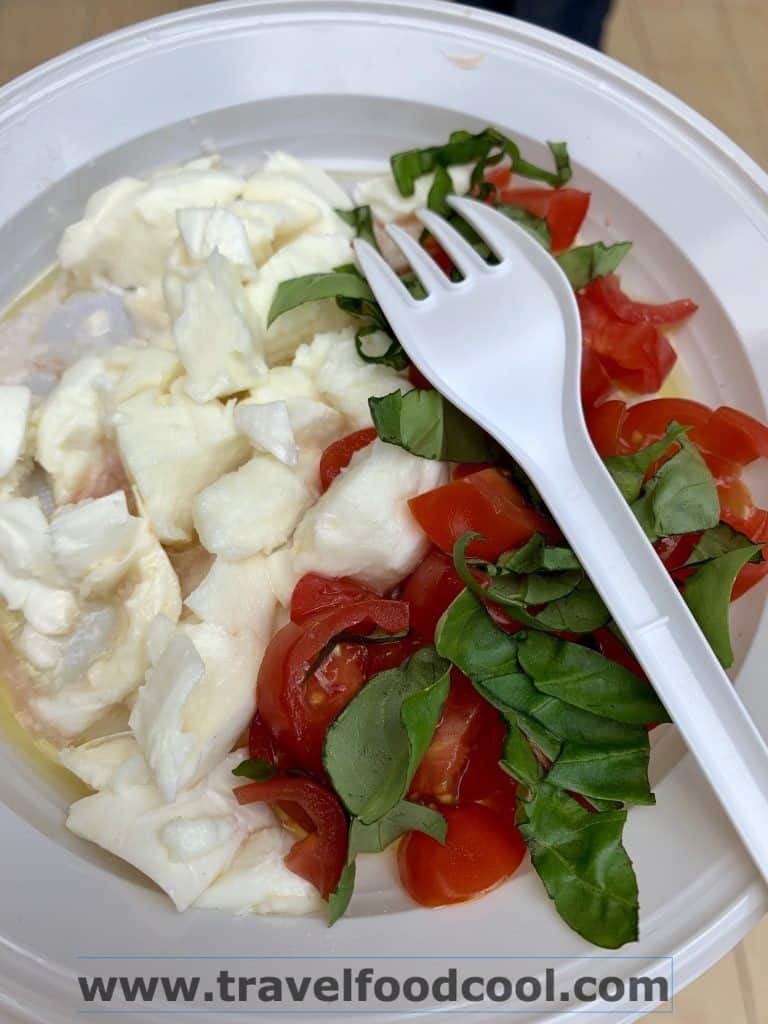
The “Egyptian cows” were originally field workers, but after someone realized that they make incredible mozzarella, they are now spoiled and basically spend their time at buffalo spas.
We go to the local cantina in the marketplace, where one can buy sfuso or “loose” wine. We try a white wine – Vermentino – and a red wine – Cesanese from Rome – with our cheese.
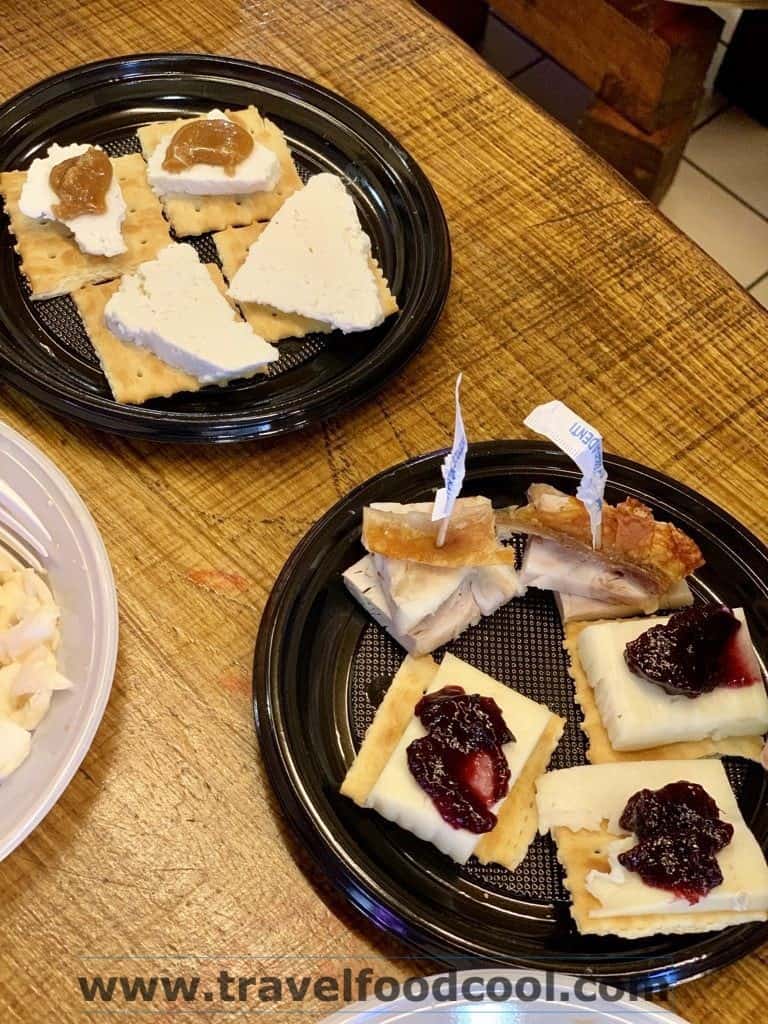
- Sheep milk ricotta (left plate, right side)
- Cow milk ricotta with honey and nuts (left plate, left side)
- Porchetta (right plate, left side)
- Stracchino with mirtillo (blueberry) jam (right plate, right side)
Al Giardino del Gatto e la Volpe (the garden of the cat and fox, named after the characters in Pinocchio) is a family run restaurant and our final spot for lunch. Lunch? How is this possible after all we have eaten?!!! (Okay, in the name of science, and for TFC readers, we will give it a try!)
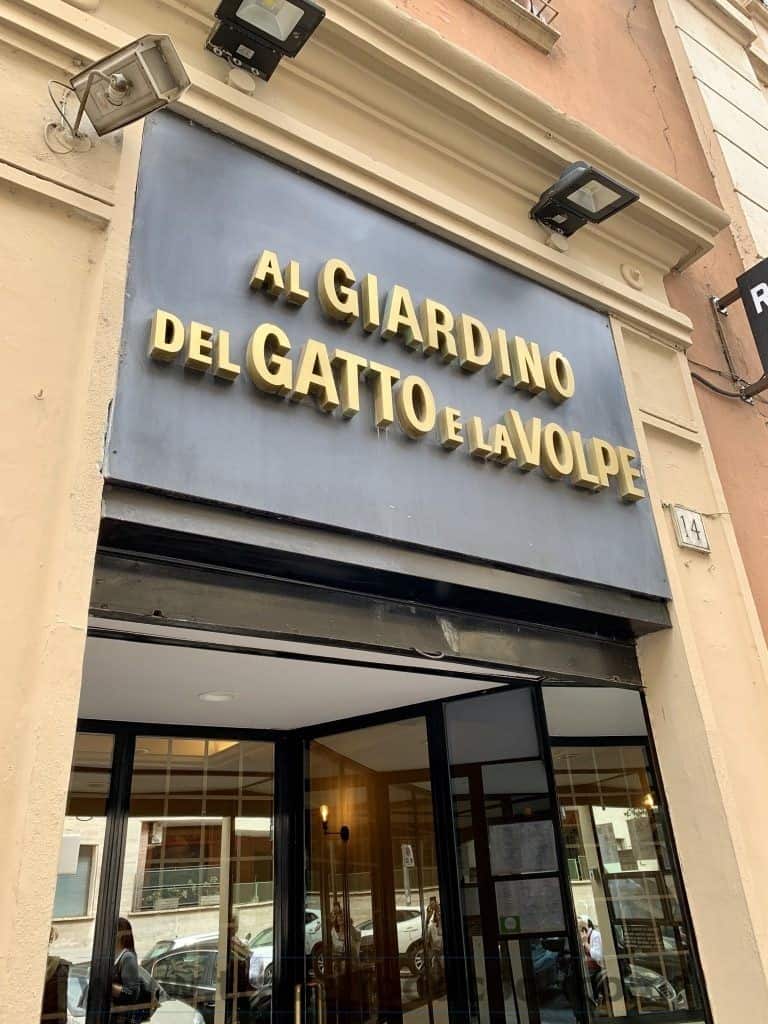
By this time we are super full. However, we can’t resist the homemade pasta gnocchi and the ravioli filled with sheep milk cheese and tomato sauce. All the pastas are made fresh in-house!
The gnocchi is amazing – light and fluffy – with four cheeses – Parmesan, pecorino, fontina, and Emmental. The ravioli is stuffed with cheese and covered in a light but very flavourful tomato sauce. I will be going back to this spot for dinner when I haven’t already eaten my body weight in meats and cheeses!
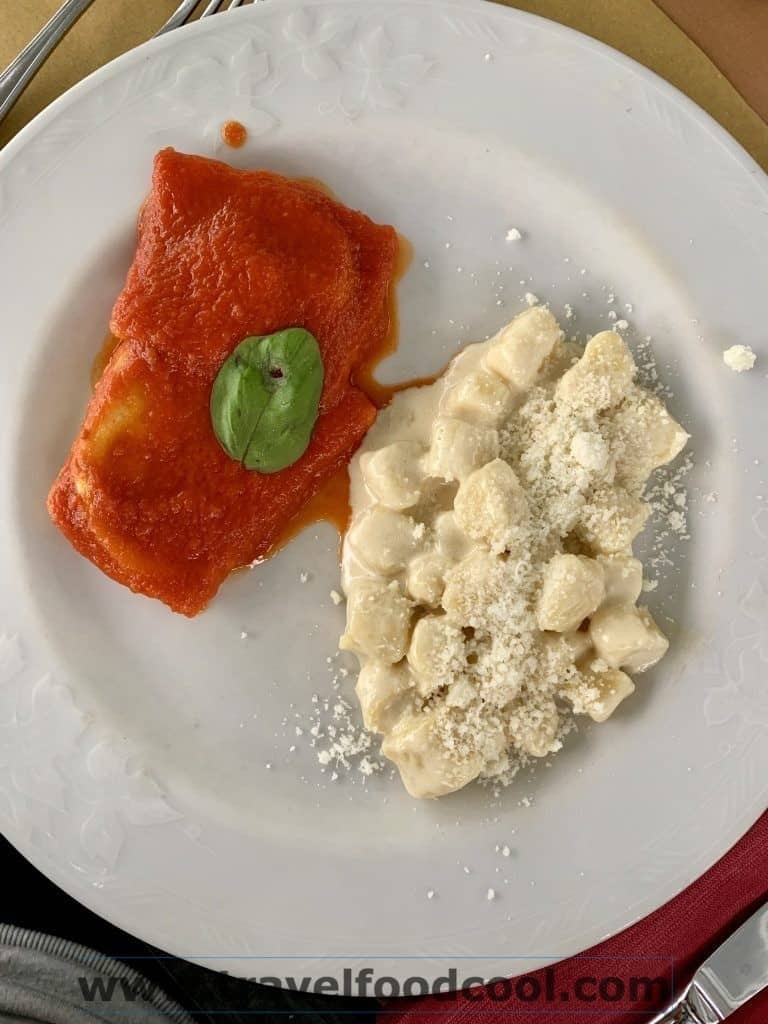
As a bonus, the recipe for the gnocchi is on the on back of the card that we are given that handily lists all the spots we toured.
After lunch, what else but gelato! I know at this point that we are waddling and can’t even think about more food, but as Luisa points out, “it’s gelato, it’s light…” so we say yes and find ourselves at Fatamorgana. Fatamorgana translates to mirage and when you are in there, you think you may be seeing an oasis of gelato-y goodness!
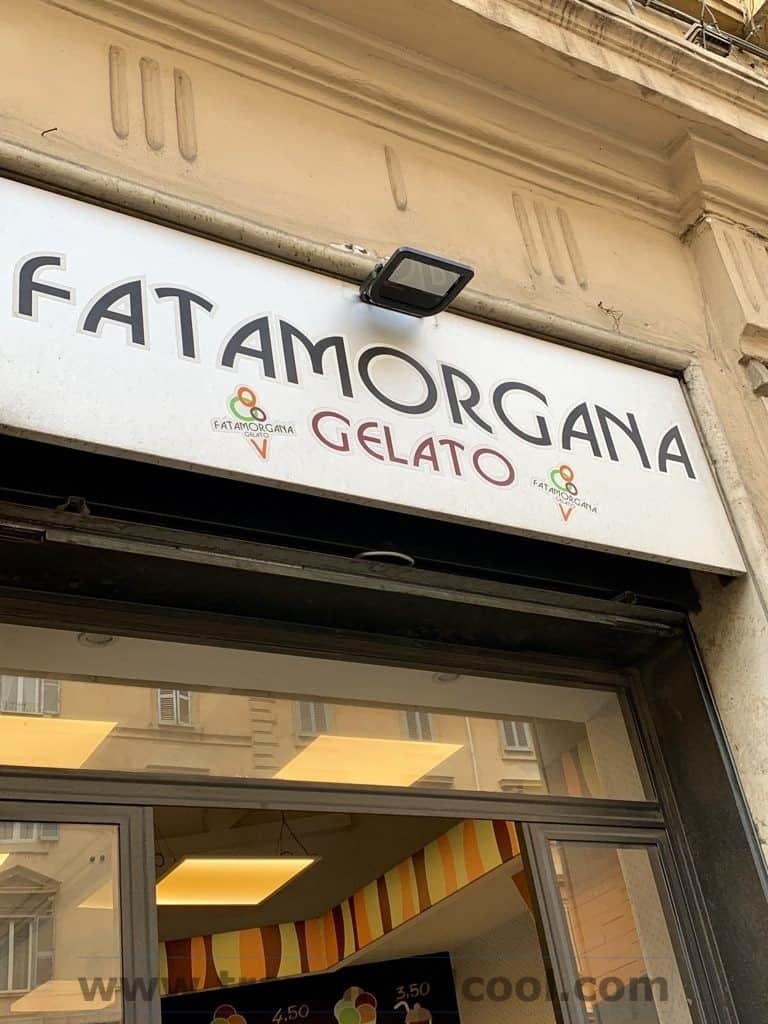
Flavours galore – there is a line-up of different types of chocolates – and unusual combinations (Sorrento Walnuts/Rose Petals/Violette Flowers; Matcha Green Tea or Pear/Gorgonzola anyone?).
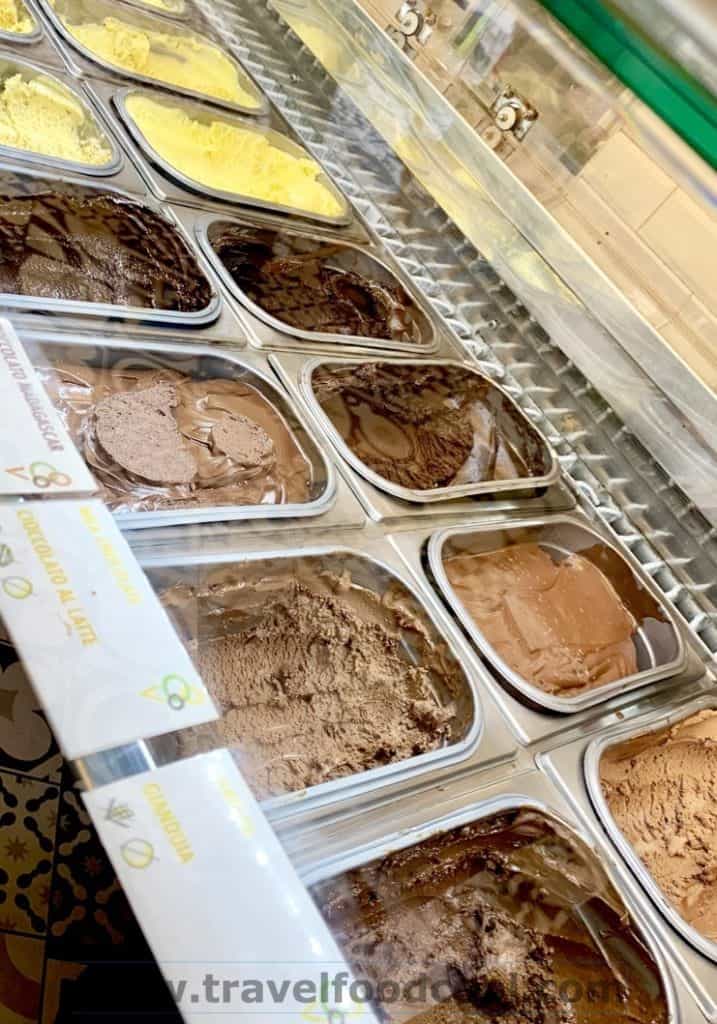
This is a chain which counts six locations in Rome, so you may get lucky and come across it in your travels.
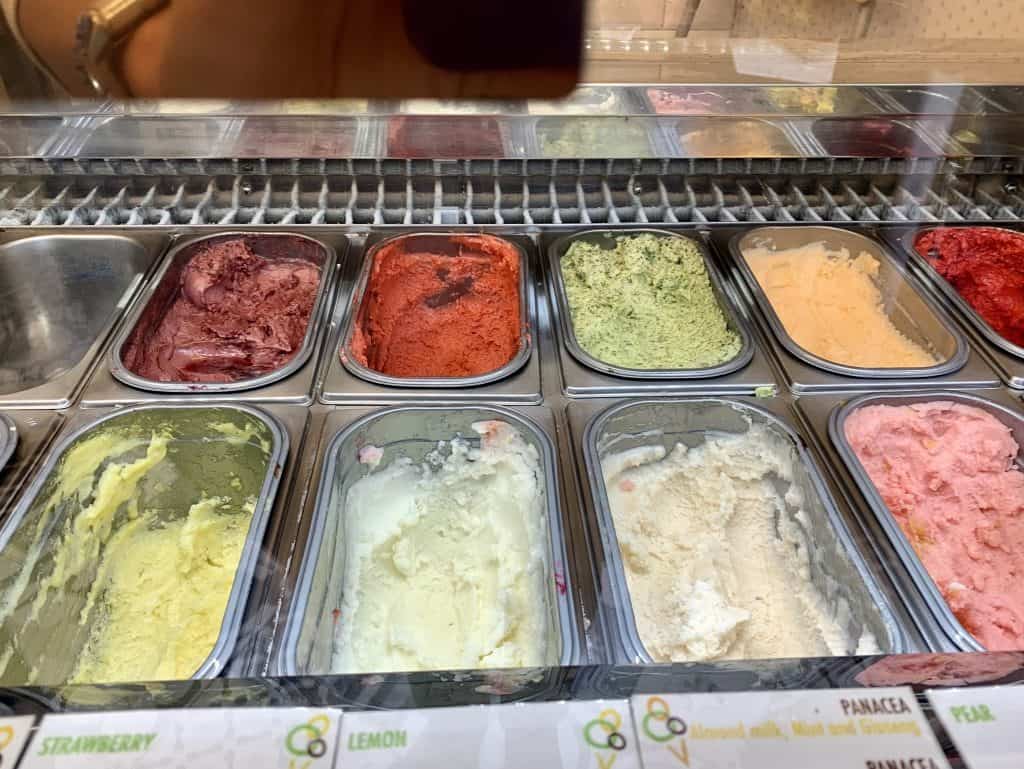
I had a coffee scoop and a lemon ginger scoop. So delicious!
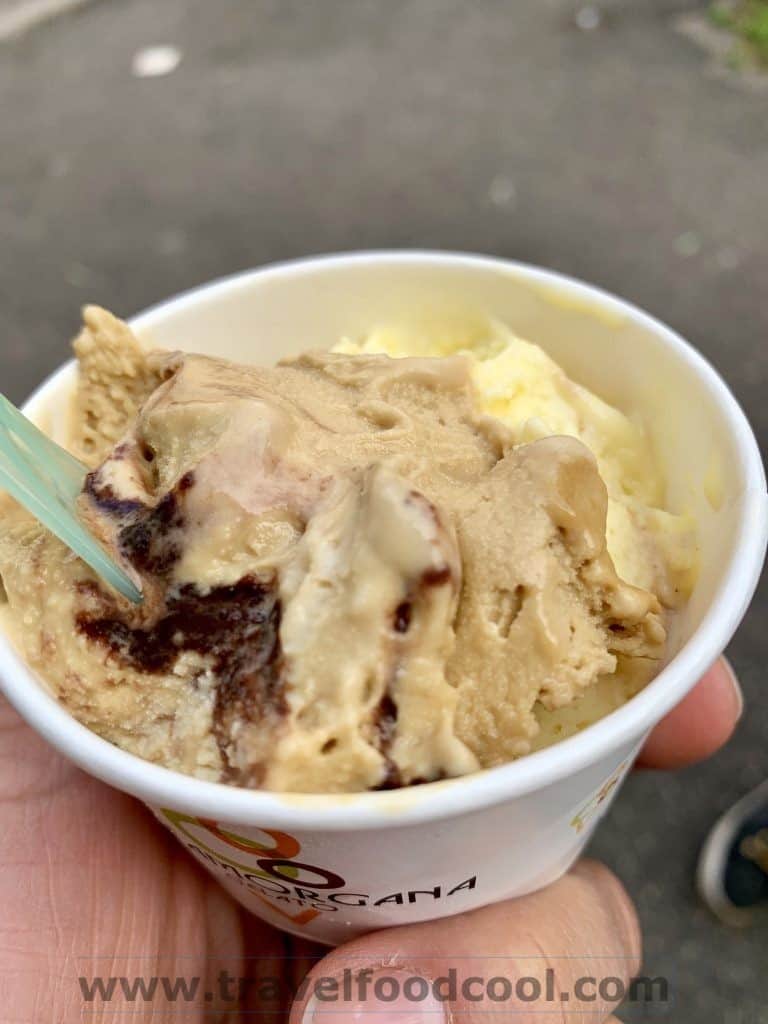
A huge thank you to Luisa for taking us around and showing us the Prati area. She was an amazing guide and we loved spending the tour with her!
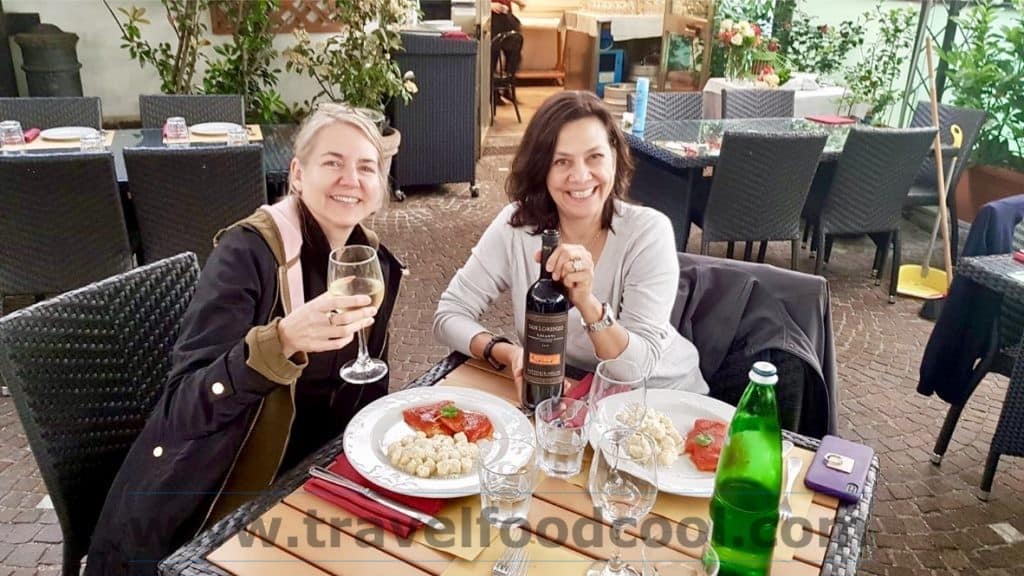
I would definitely recommend the Roman Food Tour! Not only do you get to try some spectacular foods, but you get to see an undiscovered area of Rome. If you are a foodie, this is a must! You have a great opportunity to be guided around by someone who is truly passionate about food and try some of the amazing products that make everyone love Italy.
The Roman Food Tour also offers Prati by Night, Trastevere by Night, Eating and Drinking at Historic Sites and a Cooking Class.
To book: Roman Food Tour






















Great post, Elin – really enjoyed it!
Thanks Nancy! It was a fun tour. I’d really recommend it if you are looking for something different to do in Rome!